Economics > EXAM > ECON 102 Final Exam Quizzes HW Lecture and Transcript. Score 100%. All the quizzes and final exam in (All)
ECON 102 Final Exam Quizzes HW Lecture and Transcript. Score 100%. All the quizzes and final exam in here in these 99 pages.
Document Content and Description Below
ECON 102 Final Exam Quizzes HW Lecture and Transcript Points Awarded 10.00 Points Missed 0.00 Percentage 100% 1. Which two industry structures are characterized by easy entry and exit? ... A) Perfect competition and monopolistic competition B) Oligopoly and monopoly. C) Oligopoly and monopolistic competition D) Perfect competition and monopoly E) Oligopoly and perfect competition Feedback: Assumptions made about the different industry structures Table for Individual Question Feedback 1.0/1.0 A 2. In monopolistic competition, A) there is only one firm. B) firms are large relative to the total market. C) firms are small relative to the total market. D) firms produce identical products. Feedback: Assumptions made about the different industry structures Table for Individual Question Feedback 1.0/1.0 C 3. Unlike a monopolist’s product, a monopolistically competitive firm’s product A) has many close substitutes B) has no close substitutes C) is homogeneous D) is unique Feedback: Firms in monopolistic competition produce differentiated products which are close substitutes for each other, Table for Individual Question Feedback 1.0/1.0 A 4. Which of the following industries is most similar to monopolistic competition? A) The pizza industry in State College B) The soft drink industry C) The wheat industry D) The steel industry Feedback: The pizza industry in State College has many firms that produce differentiated products. It is also easy to enter and exit the industry. Table for Individual Question Feedback 1.0/1.0 A 5. In a monopolistically competitive industry, in long run equilibrium A) firms produce at minimum average total cost and make zero economic profit. B) firms produce at greater than minimum average total cost and make positive economic profit. C) firms produce at greater than minimum average total cost and make zero economic profit. D) firms produce at minimum average total cost and make positive economic profit. Feedback: In long run equilibrium, firms make zero economic profit because of free entry and exit. However they do not produce at minimum average total cost. Table for Individual Question Feedback 1.0/1.0 C 6. For a monopolistically competitive firm, A) price is less than marginal revenue. B) price is equal to marginal revenue. C) price can be greater than or less than marginal revenue. D) price is greater than marginal revenue. Feedback: Since a monopolistically competitive firm faces a downward sloping demand curve, price is greater than marginal revenue. Table for Individual Question Feedback 1.0/1.0 D 7. A monopolistically competitive firm A) must lower price to sell more output. B) can change output, but cannot change price. C) can sell as much output as it wants at the market price. D) sells a fixed amount of output, regardless of price. Feedback: A monopolistically competitive firm faces a downward sloping demand curve, so it must lower price to sell more output. Table for Individual Question Feedback 1.0/1.0 A 8. Monopolistically competitive firms in long run equilibrium produce at _________ than the optimal scale. A) less than B) more than C) sometimes more and sometimes less than D) exactly Feedback: A monopolistically competitive firm in long run equilibrium will produce a quantity less than the quantity that minimizes ATC Table for Individual Question Feedback 1.0/1.0 A 9. Refer to the figure above. If this firm is monopolistically competitive, in order to maximize profit, it should charge a price of A) $10 B) $20 C) $23 D) $18 Feedback: The firm should produce where MR = MC, and charge as much as the demand curve will allow at that quantity. Table for Individual Question Feedback 1.0/1.0 C 10. Informative advertising A) is designed to change a consumer’s preferences and is usually associated with experience goods. B) is designed to change a consumer’s preferences and is usually associated with search goods. C) is designed to describe a product’s characteristics and is usually associated with search goods. D) is designed to describe a product’s characteristics and is usually associated with experience goods. Feedback: Informative advertising is designed to describe a product’s characteristics and is usually associated with search goods. Table for Individual Question Feedback 1.0/1.0 C Submitted by ROBERTSON, KRISTI (KLR5625) on 4/10/2016 4:19:47 PM Points Awarded 8.00 Points Missed 2.00 Percentage 80.0% 1. Which two industry structures are characterized by easy entry and exit? A) Perfect competition and monopoly B) Oligopoly and monopoly. C) Perfect competition and monopolistic competition D) Oligopoly and monopolistic competition E) Oligopoly and perfect competition Feedback: Assumptions made about the different industry structures Table for Individual Question Feedback 1.0/1.0 C 2. Monopolistic competition differs from perfect competition because A) there are barriers to entry in monopolistic competition B) firms can differentiate their products in perfect competition C) firms can differentiate their products in monopolistic competition D) there are no barriers to entry in monopolistic competition Feedback: Assumptions made about the different industry structures Table for Individual Question Feedback 1.0/1.0 C 3. Which of the following industries is most similar to monopolistic competition? A) The steel industry B) The wheat industry C) The soft drink industry D) The pizza industry in State College Feedback: The pizza industry in State College has many firms that produce differentiated products. It is also easy to enter and exit the industry. Table for Individual Question Feedback 0.0/1.0 D 4. A monopolistically competitive firm faces A) A perfectly elastic demand curve. B) A vertical demand curve. C) A horizontal demand curve. D) A downward sloping demand curve. Feedback: Because of product differentiation, if a monopolistically competitive firm raises its price, it will lose some, but not all of its customers. Table for Individual Question Feedback 1.0/1.0 D 5. For a monopolistically competitive firm, in long run equilibrium A) P > MR > MC B) P < MR = MC C) P = MR = MC D) P > MR = MC Feedback: Since a monopolistically competitive firm faces a downward sloping demand curve, price is greater than marginal revenue. Since the firm is maximizing profit in long run equilibrium, MR = MC. Table for Individual Question Feedback 1.0/1.0 D 6. Suppose a monopolistically competitive firm in the short run is selling 100 units of output at $10 each. At that level of output, MR = MC and marginal cost is rising. Also, ATC = $15, AVC = $12 and AFC = $3. This firm should A) increase output to the point where price equals marginal cost. B) decrease output to the point where marginal cost equals average total cost. C) shut down and produce 0 units of output. D) continue to produce 100 units of output since MR = MC. Feedback: Since P < AVC, the firm should shut down. Table for Individual Question Feedback 1.0/1.0 C 7. A monopolistically competitive firm A) sells a fixed amount of output, regardless of price. B) can sell as much output as it wants at the market price. C) can change output, but cannot change price. D) must lower price to sell more output. Feedback: A monopolistically competitive firm faces a downward sloping demand curve, so it must lower price to sell more output. Table for Individual Question Feedback 1.0/1.0 D 8. Compared to a perfectly competitive firm with the same costs, a monopolistically competitive firm produces _________ output and charges a _________ price. A) less; lower B) less; higher C) more; higher D) more; lower Feedback: A monopolistically competitive firm produces where MR = MC. Since P > MR, the firm produces less output and charges a higher price. Table for Individual Question Feedback 1.0/1.0 B 9. Refer to the figure above. If this firm is monopolistically competitive and is maximizing profit, its total revenue is A) $200 B) $460 C) $60 D) $400 Feedback: TR = P*Q Table for Individual Question Feedback 0.0/1.0 B 10. Informative advertising is usually associated with A) normal goods B) experience goods C) inferior goods D) search goods Feedback: Informative advertising describes a product’s characteristics. Table for Individual Question Feedback 1.0/1.0 D Submitted by ROBERTSON, KRISTI (KLR5625) on 4/16/2016 3:57:48 PM Points Awarded 10.00 Points Missed 0.00 Percentage 100% 1. Suppose that two players are playing the following game. Player 1 can choose either Top or Bottom, and Player 2 can choose either Left or Right. The payoffs are given in the following table: where the number on the left is the payoff to Player A, and the number on the right is the payoff to Player B. Player A has _____________________, and player B has ___________________ Player B Player A Left Right Top 4 2 2 3 Bottom 3 3 1 4 A) None of these B) no dominant strategy; a dominant strategy to play Left. C) a dominant strategy to play Top; a dominant strategy to play Right. D) no dominant strategy; a dominant strategy to play Right E) a dominant strategy to play Bottom; no dominant strategy. Feedback: Definition of dominant strategy. Table for Individual Question Feedback 1.0/1.0 C 2. Suppose that two players are playing the following game. Player 1 can choose either Top or Bottom, and Player 2 can choose either Left or Right. The payoffs are given in the following table: where the number on the left is the payoff to Player A, and the number on the right is the payoff to Player B. The Nash Equilibrium in pure strategies in this game is Player B Player A Left Right Top 4 2 2 3 Bottom 3 5 4 2 A) Bottom/Right B) Top/Left C) Top/Right D) Bottom/Left E) None of these Feedback: Definition of Nash Equilibrium. Table for Individual Question Feedback 1.0/1.0 E 3. Suppose that two players are playing the following game. Player 1 can choose either Top or Bottom, and Player 2 can choose either Left or Right. The payoffs are given in the following table: where the number on the left is the payoff to Player A, and the number on the right is the payoff to Player B. If each player plays their maximin strategy, the outcome of the game will be Player B Player A Left Right Top 8 4 0 5 Bottom 3 3 1 2 A) Bottom/Right B) Top/Left C) Top/Right D) Bottom/Left Feedback: Definition of maximin strategy. Table for Individual Question Feedback 1.0/1.0 D 4. Refer to the Game Tree above: If both players are trying to maximize their own payoffs, the likely outcome of this game is that A) Tracy gets 100 and Amy gets 175. B) Tracy gets 500 and Amy gets 150. C) Tracy gets 175 and Amy gets 130. D) Tracy gets 275 and Amy gets 140. Feedback: Use Backward Induction. Table for Individual Question Feedback 1.0/1.0 D 5. Which of the following industries is NOT an oligopoly? A) US Soft Drink Industry B) US Wheat Industry C) US Airline Industry D) US Automobile Industry Feedback: Definition of oligopoly. Table for Individual Question Feedback 1.0/1.0 B 6. Which of the following industries is NOT an oligopoly? A) US Soft Drink Industry B) US Corn Industry C) US Beer Industry D) US Fast Food Industry Feedback: Definition of oligopoly. Table for Individual Question Feedback 1.0/1.0 B 7. Mergers that substantially reduce competition are outlawed by the A) Sherman Act B) None of these C) Clayton Act D) Federal Trade Commission Act Feedback: The Clayton Act outlaws tying contracts, mergers, and price discrimination that substantially lessen competition. Table for Individual Question Feedback 1.0/1.0 C 8. Suppose an industry has 4 firms each with 15% of sales, and 8 firms each with 5% of sales. The HHI for this industry is A) 100 B) 900 C) None of these D) 800 E) 1100 Feedback: The HHI is calculated as the sum of the squares of the percentage of sales by each firm in the industry. Table for Individual Question Feedback 1.0/1.0 E 9. Suppose there are 6 firms in an industry and they each have total sales given in the table below. The 4-firm concentration ratio for this industry is Firm Total Sales 1 $20 million 2 $15 million 3 $15 million 4 $10 million 5 $8 million 6 $7 million A) .80 B) .75 C) None of these D) .20 E) .60 Feedback: The 4 firm concentration ratio is the sum of the total sales of the 4 largest firms divided by the total sales in the industry Table for Individual Question Feedback 1.0/1.0 A 10. In the Cournot Model of Oligopoly, A) price is higher than the monopoly price B) price is lower than the monopoly price, but higher than the perfectly competitive price C) price equals the perfectly competitive price D) price is lower than the perfectly competitive price Feedback: Price is between the monopoly price and the perfectly competitive price Table for Individual Question Feedback 1.0/1.0 B Submitted by ROBERTSON, KRISTI (KLR5625) on 4/20/2016 7:00:23 PM Points Awarded 10.00 Points Missed 0.00 Percentage 100% 1. When a paper manufacturer emits pollution levels above the socially efficient level, we can conclude that the manufacturer A) is not maximizing profit B) pays the entire cost of producing the paper. C) does not pay the entire cost of producing the paper. D) pays a tax equal to the negative externality that paper manufacturing produces Feedback: When a negative production externality exists, the firm does not bear the full social cost of production, the firm only pays the private cost of production. Table for Individual Question Feedback 1.0/1.0 C 2. A profit maximizing competitive firm in a market with NO externalities will produce the quantity of output where A) marginal benefit = marginal cost B) all of these are true C) price = marginal cost D) marginal revenue = marginal cost Feedback: All of the conditions listed describe competitive equilibrium. Table for Individual Question Feedback 1.0/1.0 B 3. Consider the graph above. If this market is currently producing an output level of Q2, total economic surplus would increase if A) production decreased to Q1 B) production increased to Q3 C) economic surplus is already maximized at Q2, so changing the output level would only decrease total economic surplus D) production decreased to Q0 Feedback: The optimal production point occurs where MSC=MB, this is where total economic surplus is maximized. Table for Individual Question Feedback 1.0/1.0 A 4. A positive externality can be internalized via A) subsidies B) taxes C) pollution permits D) all of these are true Feedback: Subsidies are often used to internalize positive externalities. Table for Individual Question Feedback 1.0/1.0 A 5. Which of the following is a solution to the problem of externalities? A) regulation B) sale of the right to impose externalities C) private bargaining D) all of these are potential solutions to externalities Feedback: Each choice listed can potentially be used to eliminate the effects of externalities. Table for Individual Question Feedback 1.0/1.0 D 6. The Coase theorem states that when externalities are present, under certain conditions A) private parties will hold out for a better deal, making achieving the efficient outcome impossible B) private parties can never achieve an efficient outcome C) private parties can achieve the efficient outcome without government intervention D) private parties can achieve the efficient outcome if there is government intervention Feedback: Under the Coase theorem, private parties may be able to achieve the efficient outcome without assistance from the government. Table for Individual Question Feedback 1.0/1.0 C 7. Private goods are A) exclusive B) non-rival C) non-rival and non-excludable D) rival and excludable Feedback: Private goods are both rival and excludable. Table for Individual Question Feedback 1.0/1.0 D 8. Quantity of the public good Willingness to pay of person 1 Willingness to pay of person 2 1 100 55 2 90 50 3 80 45 4 70 40 5 60 35 Consider the table above. If you use this information to construct the market demand curve for this public good, a point on the market demand would be A) 1, $100 B) 2, $140 C) 3, $80 D) 4, $40 Feedback: The market demand for a public good is the vertical summation of all of the individual demands for that good. Table for Individual Question Feedback 1.0/1.0 B 9. Quantity of the public good Willingness to pay of person 1 Willingness to pay of person 2 1 100 55 2 90 50 3 80 45 4 70 40 5 60 35 Consider the table above. How much is society willing to spend on a total of 3 units of this public good? A) $155 B) $420 C) $90 D) $530 Feedback: The total amount society is willing to pay for all 3 units of the public good is the market willingness to pay at Q= 1 plus the market willingness to pay at Q=2 plus the market willingness to pay at Q=3. Table for Individual Question Feedback 1.0/1.0 B 10. A person that has many health problems or a high risk of developing many health problems is likely to buy a lot of health insurance. This situation is an example of A) the impossibility theorem B) adverse selection C) the Tiebout hypothesis D) moral hazard Feedback: In this situation the person buying insurance has more information than the seller of the insurance. Table for Individual Question Feedback 1.0/1.0 B Submitted by ROBERTSON, KRISTI (KLR5625) on 4/29/2016 10:01:09 PM Points Awarded 5.00 Points Missed 5.00 Percentage 50.0% 1. Suppose the demand for a product is given by P = 100 – 2Q. Also, the supply is given by P = 20 + 6Q. If an $8 per-unit excise tax is levied on the buyers of a good, then after the tax buyers will pay _________ for each unit of the good. A) None of these B) $82 C) $9 D) $74 E) $80 Feedback: The demand curve will shift down by an amount exactly equal to the tax. This allows you to find the equation for the new demand curve. The buyers will pay a price equal to the new equilibrium price plus the tax. Table for Individual Question Feedback 0.0/1.0 B 2. Suppose the demand for a product is given by P = 100 – 2Q. Also, the supply is given by P = 20 + 6Q. If an $8 per-unit excise tax is levied on the buyers of a good, then after the tax the sellers will receive _________ for each unit of the good. A) None of these B) $74 C) $9 D) $80 E) $82 Feedback: The demand curve will shift down by an amount exactly equal to the tax. This allows you to find the equation for the new demand curve. The sellers will receive a price equal to the new equilibrium price. Table for Individual Question Feedback 0.0/1.0 B 3. Suppose the demand for a product is given by P = 30 – 3Q. Also, the supply is given by P = 10 + Q. If a $4 per-unit excise tax is levied on the buyers of a good, what proportion of the tax will be paid by the buyers? A) 40% B) None of these C) 20% D) 0% E) 25% Feedback: The proportion of the tax paid by buyers depends on the relative price elasticities of supply and demand. Table for Individual Question Feedback 0.0/1.0 B 4. Suppose the demand for a product is given by P = 30 – 2Q. Also, the supply is given by P = 5 + 3Q. If a $5 per-unit excise tax is levied on the buyers of a good, the deadweight loss created by this tax will be A) $5 B) $16 C) $2.50 D) $4 E) None of these Feedback: The deadweight loss is the difference between total surplus without the tax and total surplus with the tax. Table for Individual Question Feedback 1.0/1.0 C 5. Suppose the demand for a product is given by P = 40 – 4Q. Also, the supply is given by P = 10 + Q. If a $10 per-unit excise tax is levied on the buyers of a good, consumer surplus is equal to A) None of these B) $10 C) $64 D) $8 E) $32 Feedback: Consumer surplus is the area under the demand curve and above the price that the consumer pays. Table for Individual Question Feedback 1.0/1.0 E 6. Suppose the demand for a product is given by P = 30 – 2Q. Also, the supply is given by P = 5 + 3Q. If a $5 per-unit excise tax is levied on the buyers of a good, after the tax, producer surplus is equal to A) $25 B) None of these C) $64 D) $24 E) $20 Feedback: Producer surplus is the area under the price that producers receive, and above the supply curve. Table for Individual Question Feedback 1.0/1.0 D 7. Suppose the demand for a product is given by P = 40 – 4Q. Also, the supply is given by P = 10 + Q. If a $10 per-unit excise tax is levied on the buyers of a good, government revenue is equal to A) $32 B) None of these C) $64 D) $8 E) $10 Feedback: Government revenue equals the amount of the tax times the number of units sold after the tax. Table for Individual Question Feedback 0.0/1.0 B 8. Suppose the demand for a product is given by P = 60 –2Q. Also, the supply is given by P = 10 + 3Q. If a $10 per-unit excise tax is levied on the buyers of a good, after the tax, the total amount of tax paid by the consumers is A) $10 B) None of these C) $48 D) $32 E) $80 Feedback: The total tax paid by the consumer is equal to (Pt + t –P*. times Qt. Table for Individual Question Feedback 1.0/1.0 D 9. Suppose the demand for a product is given by P = 50 –Q. Also, the supply is given by P = 10 + 3Q. If a $12 per-unit excise tax is levied on the buyers of a good, after the tax, the total amount of tax paid by the producers is A) $21 B) $84 C) $18 D) $63 E) None of these Feedback: The total tax paid by the producer is equal to (P* - Pt. times Qt. Table for Individual Question Feedback 1.0/1.0 D 10. Suppose the demand for a product is given by P = 50 –Q. Also, the supply is given by P = 10 + 3Q. If a $12 per-unit excise tax is levied on the buyers of a good, after the tax, the total quantity of the good sold is A) 7 B) 31 C) 10 D) None of these E) 6 Feedback: Qt can be found by the intersection of the new demand curve and the original supply curve. Table for Individual Question Feedback 0.0/1.0 A HOMEWORK Submitted by ROBERTSON, KRISTI (KLR5625) on 4/16/2016 4:14:52 PM Points Awarded 99.00 Points Missed 1.00 Percentage 99.0% 1. Suppose that a monopolistically competitive firm must build a production facility in order to produce a product. The fixed cost of this facility is FC = $24. Also, the firm has constant marginal cost, MC = $3. Demand for the product that the firm produces is given by P = 27-3Q. Fill in the table below. Some numbers have been filled in for you. Hint: All answers that you fill in will be integers (no decimals). Be sure to just type the numbers and do not type in dollar signs. Another Hint: It may be best if you print out the table first and fill it in by hand and then type in your answers. Quantity of Output Price Total Cost Average Total Cost Total Revenue Profits 1 2 3 4 5 7.8 6 7 6.4 8 9 5.7 Table for Individual Question Feedback 20.0/21.0 Box 1: 24; Box 10: 27; Box 19: 27; Box 25: 24; Box 34: -3; Box 2: 21; Box 11: 30; Box 20: 15; Box 26: 42; Box 35: 12; Box 3: 18; Box 12: 33; Box 21: 11; Box 27: 54; Box 36: 21; Box 4: 15; Box 13: 36; Box 22: 9; Box 28: 60; Box 37: 24; Box 5: 12; Box 14: 39; Box 29: 60; Box 38: 21; Box 6: 9; Box 15: 42; Box 23: 7; Box 30: 54; Box 39: 12; Box 7: 6; Box 16: 45; Box 31: 42; Box 40: -3; Box 8: 3; Box 17: 48; Box 24: 6; Box 32: 24; Box 41: -24; Box 9: 0; Box 18: 51; Box 33: 0; Box 42: -51 2. Enter just a number to answer this problem. How many units of output will the firm produce if maximizes its profit? Table for Individual Question Feedback 2.0/2.0 4 3. Enter just a number to answer this problem. What price should this firm charge if it wants to maximize its profit? Table for Individual Question Feedback 2.0/2.0 15 4. Monopolistic competition differs from perfect competition primarily because in monopolistic competition, A) firms can differentiate their products. B) entry into the industry is blocked. C) there are relatively few barriers to entry. Table for Individual Question Feedback 2.0/2.0 A 5. The demand facing a monopolistically competitive firm is ________ a monopoly firm and ________ a perfectly competitive firm. A) as elastic as; less elastic than B) less elastic than; more elastic than C) more elastic than; less elastic than D) more elastic than; as elastic as Table for Individual Question Feedback 2.0/2.0 C 6. If firms in a monopolistically competitive industry are earning economic profits, then in the long run A) these firms can continue earning economic profits because entry into the industry is blocked. B) new firms producing close substitutes will enter the industry and this entry will continue until economic profits are eliminated. C) new firms producing the exact same product will enter the industry and this entry will continue until economic profits are eliminated. D) the government will most likely regulate firms in this industry to reduce these economic profits. Table for Individual Question Feedback 2.0/2.0 B 7. For a monopolistically competitive firm in long-run equilibrium, A) the demand curve must intersect the average total cost curve at the ATC curve minimum. B) the demand curve must be tangent to the average total cost curve at the ATC curve minimum. C) at the profit-maximizing quantity, the demand curve must intersect the average total cost curve. D) at the profit-maximizing quantity, the demand curve must be tangent to the average total cost curve. Table for Individual Question Feedback 2.0/2.0 D 8. We know that monopolistically competitive firms prevent the efficient use of resources because they produce where A) P > ATC. B) P > MC. C) MR > P. D) P = MC. Table for Individual Question Feedback 2.0/2.0 B 9. When monopolistically competitive firms earn ________ economic profits, other firms ________ an industry in the long run. A) positive; enter B) zero; enter C) negative; enter D) zero; exit Table for Individual Question Feedback 2.0/2.0 A 10. Firms will ________ a monopolistically competitive market until ________ are eliminated. A) enter; losses B) enter; profits C) exit; short run profits D) exit; long run profits Table for Individual Question Feedback 2.0/2.0 B 11. When MR = MC and P = ATC for a monopolistically competitive firm, the firm is in A) short‐run disequilibrium. B) long‐run disequilibrium. C) long‐run equilibrium. D) neither short‐run nor long‐run equilibrium. Table for Individual Question Feedback 2.0/2.0 C 12. Refer to the graph above, which represents the demand and cost curves for Neat and Trim Barber Shop, a monopolistically competitive firm. The profit-maximizing number of haircuts for the Barber Shop is A) 20 B) 23 C) 25 D) 30 E) some value less than 20 Table for Individual Question Feedback 2.0/2.0 A 13. Refer to the graph again. The profit-maximizing price of haircuts by Neat and Trim is A) $10 B) $12 C) $14 D) $16 E) some price less than $10 Table for Individual Question Feedback 2.0/2.0 D 14. If Neat and Trim maximizes profits, it ________ of $80. A) receives a total revenue B) earns a profit C) has a total cost D) suffers a loss Table for Individual Question Feedback 2.0/2.0 B 15. If Neat and Trim maximizes profits, its ________ equals $320. A) total cost B) total revenue C) profit D) variable cost E) average cost F) marginal cost G) marginal revenue Table for Individual Question Feedback 2.0/2.0 B 16. If Neat and Trim maximizes profits, its ________ is $240. A) total revenue B) total cost C) profit D) marginal revenue E) average cost F) marginal cost G) price Table for Individual Question Feedback 2.0/2.0 B 17. Refer to the graph. From society's point of view, the efficient output level is ______ haircuts. A) 20 B) 23 C) 25 D) 30 E) whatever amount of haircuts that occur at the horizontal intercept of the demand function Table for Individual Question Feedback 2.0/2.0 C 18. Refer to the graph again. Suppose that the profits or losses incurred by Neat and Trim are a reflection of the Barber Shop industry as a whole. In the Barber Shop industry, in the long run, A) firms will continue to earn economic profits. B) firms will enter until all firms earn zero economic profit. C) product demand will become perfectly inelastic D) the government will impose price controls to eliminate any economic profits. Table for Individual Question Feedback 2.0/2.0 B 19. Suppose that two players are playing the following game. Player A can choose either Top or Bottom, and Player B can choose either Left or Right. The two players choose their strategies simultaneously. The payoffs are given in the table, where the number on the left is the payoff to Player A, and the number on the right is the payoff to Player B. How many possible outcomes are there in this game? A) 2 B) 4 C) 8 D) 16 Table for Individual Question Feedback 2.0/2.0 B 20. Does Player A have a dominant strategy? If so, what is it? A) Top is a dominant strategy for Player A B) Bottom is a dominant strategy for Player A C) Left is a dominant strategy for Player A D) Right is a dominant strategy for Player A E) There is no dominant strategy for Player A Table for Individual Question Feedback 2.0/2.0 E 21. Does Player B have a dominant strategy? If so, what is it? A) Top is a dominant strategy for Player B B) Bottom is a dominant strategy for Player B C) Left is a dominant strategy for Player B D) Right is a dominant strategy for Player B E) There is no dominant strategy for Player B Table for Individual Question Feedback 2.0/2.0 E 22. The following four questions are True/False. The strategy combination of Player A choosing Top and Player B choosing Left is a Nash Equilibrium. A) True B) False Table for Individual Question Feedback 2.0/2.0 A 23. The strategy combination of Player A choosing Top and Player B choosing Right is a Nash Equilibrium. A) True B) False Table for Individual Question Feedback 2.0/2.0 B 24. The strategy combination of Player A choosing Bottom and Player B choosing Left is a Nash Equilibrium. A) True B) False Table for Individual Question Feedback 2.0/2.0 B 25. The strategy combination of Player A choosing Bottom and Player B choosing Right is a Nash Equilibrium. A) True B) False Table for Individual Question Feedback 2.0/2.0 A 26. What is the maximin strategy for Player A? A) Top B) Bottom C) Left D) Right E) There is no maximin strategy for Player A Table for Individual Question Feedback 2.0/2.0 A 27. What is the maximin strategy for Player B? A) Top B) Bottom C) Left D) Right E) There is no maximin strategy for Player B Table for Individual Question Feedback 2.0/2.0 D 28. Now suppose the same game is played with the exception that Player A moves first and Player B moves second. Using the backward induction method discussed in the online class notes, what will be the outcome of the game? Hint: Draw the game tree associated with this situation. A) Player A chooses Top and Player B chooses Left B) Player A chooses Top and Player B chooses Right C) Player A chooses Bottom and Player B chooses Left D) Player A chooses Bottom and Player B chooses Right Table for Individual Question Feedback 2.0/2.0 D 29. The table shows an industry with 12 firms and the market share (percentage) owned by each firm. Calculate the HHI for this industry. Table for Individual Question Feedback 3.0/3.0 1042 30. If firms F and G decide to merge, what would the new HHI be? Table for Individual Question Feedback 3.0/3.0 1138 31. If firms C and D decide to merge, what would the new HHI be? (don’t assume that firms F and G have merged from the previous question). The new HHI after firms C and D merge is Table for Individual Question Feedback 3.0/3.0 1330 32. If firms C and D decide to merge. This merger would be ________ by the FTC because _______. A) challenged, the post merger HHI > 1800 B) challenged, the merger would increase HHI by more than 100 C) unchallenged, the post merger HHI < 1000 D) unchallenged, there are still 11 other firms keeping the industry competitive Table for Individual Question Feedback 3.0/3.0 B 33. Which of the following is true about antitrust law? A) The “Rule of Reason” strengthened the Sherman Act B) Antitrust legislation is generally aimed at making markets more concentrated with a smaller number of firms C) Antitrust legislation doesn’t have as many important applications today, and this is emphasized by the fact that the Clayton Act was passed more than 100 years ago D) All actions that reduce competition are deemed illegal according to antitrust law E) The Clayton act makes specific rules about economic actions being illegal if they result in a greatly reduced amount of competition Table for Individual Question Feedback 3.0/3.0 E 34. The ________ is the share of industry output in sales or employment accounted for by the top firms in an industry. A) concentration ratio B) contestability ratio C) competitive index D) collusive level E) HHI Table for Individual Question Feedback 2.0/2.0 A 35. The major distinguishing characteristic of oligopoly is that A) firms produce differentiated products. B) firms can influence the price of their product. C) entry into the industry easy. D) firms are interdependent. Table for Individual Question Feedback 2.0/2.0 D 36. The four largest firms account for approximately 90% of U.S. beer sales. The U.S. beer industry would be best classified as a(n) A) perfectly competitive industry. B) monopolistically competitive industry. C) oligopoly. D) monopoly. Table for Individual Question Feedback 2.0/2.0 C 37. Of the following, ________ is the best example of an oligopolistic industry. A) grocery stores B) automobiles production C) electric power D) soybean farming Table for Individual Question Feedback 2.0/2.0 B 38. Oligopolists must ________ to their strategy in order to determine their optimal strategy. A) anticipate the reaction of their customers B) anticipate the reaction of their rivals C) both A and B are correct. D) none of the above Table for Individual Question Feedback 2.0/2.0 C Submitted by ROBERTSON, KRISTI (KLR5625) on 4/29/2016 10:02:47 PM Points Awarded 81.00 Points Missed 19.00 Percentage 81.0% 1. The Coase theorem states that A) the private sector will fail to produce the efficient amount of a public good because of the free-rider problem. B) under certain conditions, private parties can arrive at the efficient solution without government involvement. C) if there are external costs in production, the government must intervene in the market to assure that the efficient level of output is produced. D) public goods should be produced up to the point where the additional benefit received by society equals the additional cost of producing the good. Table for Individual Question Feedback 2.0/2.0 B 2. The Coase theorem will apply only if A) the courts can be used to determine the amount of compensation that must be made to the damaged party. B) the amount of compensation that must be made to the damaged party is small. C) the number of people involved is small. D) an individual who is not affected by the externality can negotiate a settlement between the parties imposing the externality and the parties that are harmed by the externality. Table for Individual Question Feedback 2.0/2.0 C 3. An efficient outcome can always be reached by requiring the individual who produces the externality to fully compensate individuals for any damage inflicted. A) TRUE B) FALSE Table for Individual Question Feedback 2.0/2.0 B 4. According to the Coase theorem, bargaining will bring the contending parties to the correct solution only if the rights are initially assigned to the party causing the externality. A) TRUE B) FALSE Table for Individual Question Feedback 2.0/2.0 B 5. A national campaign is asking for contributions of $1.00 per citizen to fund the building of the September 11th memorial in New York City. The total cost of the memorial is estimated to be $260 million. You decide not to contribute, because your contribution would be small relative to the total that it wonʹt make any difference whether you contribute or not. This is an example of the ________ problem. A) nonexcludable B) nonrival in consumption C) free-rider D) drop-in-the-bucket Table for Individual Question Feedback 2.0/2.0 D 6. A television signal sent by cable is ________ in consumption and viewers are ________. A) rival; excludable B) nonrival; excludable C) nonrival; nonexcludable D) rival; nonexcludable Table for Individual Question Feedback 0.0/2.0 B 7. Public goods are A) rival in consumption and their benefits are excludable. B) nonrival in consumption and their benefits are excludable. C) nonrival in consumption and their benefits are nonexcludable. D) rival in consumption and their benefits are nonexcludable. Table for Individual Question Feedback 2.0/2.0 C 8. If, at a low cost, you cannot prevent a person from benefiting from the consumption of a good you produced, the good is A) excludable. B) nonexcludable. C) rival in consumption. D) nonrival in consumption. Table for Individual Question Feedback 2.0/2.0 B 9. Refer to the figure above. Suppose the government assigns property rights to the airlines. No negotiations occur between the parties. The resulting level of air travel is ________. A) 0 units B) 100 units C) 120 units D) Indeterminate from the given information. Table for Individual Question Feedback 2.0/2.0 C 10. Refer to the figure above. Suppose the government assigns property rights to the airlines. No negotiations occur between the parties. The marginal damage cost associated with the resulting level of air travel is ________. A) $25 B) $120 C) $265 D) $385 Table for Individual Question Feedback 2.0/2.0 B 11. Refer to the figure above. Suppose the government assigns property rights to the airlines, then the airlines and the residents engage in negotiations. The resulting efficient level of air travel is ________. A) 0 units B) 100 units C) 120 units D) Indeterminate from the given information. Table for Individual Question Feedback 2.0/2.0 B 12. Refer to the figure above. The marginal damage cost associated with the efficient level of air travel is ________. A) $0 B) $100 C) $225 D) $265 Table for Individual Question Feedback 0.0/2.0 B 13. Refer to the figure above. The marginal damage cost ________ as the quantity of air travel increases. A) increases B) decreases C) remains constant D) becomes negative Table for Individual Question Feedback 2.0/2.0 A 14. Refer to the figure above. Suppose the government assigns property rights to the nearby residents affected by the airlines. No negotiations occur between the parties. The resulting level of air travel is ________. A) 0 units B) 100 units C) 120 units D) Indeterminate from the given information. Table for Individual Question Feedback 2.0/2.0 A 15. For the following question, you will need to fill in the blankswith the correct numbers. When filling in the blanks, enter the NUMBERS only. Do NOT enter commas, dollar signs, percent signs, or text. If your answer is a decimal, include your decimal point and round to the nearest tenth. Consider the fictitious good Derp. The demand for Derp is Q = 1200 – 2P. Suppose the supply of Derp is given by Q = –600 +2P. What is the equilibrium price of Derp? What is the equilibrium quantity of Derp? What is the price elasticity of demand at the equilibrium price and quantity? What is the price elasticity of supply at the equilibrium price and quantity? For the next seven questions, suppose a per-unit excise tax of $50 per Derp is levied on the consumers. What price will sellers receive after the tax is levied? What price will consumers pay after the tax is levied? What percent of the tax will be paid by the consumers of Derp? (give an answer between 0 and 100) What percent of the tax will be paid by the suppliers of Derp? (give an answer between 0 and 100) How many Derps will be sold after the tax is imposed? How much consumer surplus do consumers get after the tax? What is the deadweight loss created by this tax? Table for Individual Question Feedback 33.0/33.0 Box 1: 450; Box 2: 300; Box 3: 3, -3; Box 4: 3; Box 5: 425; Box 6: 475; Box 7: 50; Box 8: 50; Box 9: 250; Box 10: 15625; Box 11: 1250 16. For the following question, you will need to fill in the blankswith the correct numbers. When filling in the blanks, enter the NUMBERS only. Do NOT enter commas, dollar signs, percent signs, or text. If your answer is a decimal, include your decimal point and round to the nearest tenth. Consider the market for laptop computers. The demand for laptops is Q = 1800 – 3P. Suppose the supply of laptops is given by Q = –200 +2P. What is the equilibrium price of laptops? What is the equilibrium quantity of laptops? What is the price elasticity of demand at the equilibrium price and quantity? What is the price elasticity of supply at the equilibrium price and quantity? For the next seven questions, suppose a per-unit excise tax of $80 per laptops is levied on the consumers. What price will sellers receive after the tax is levied? What price will consumers pay after the tax is levied? What percent of the tax will be paid by the consumers of laptops? (give an answer between 0 and 100) What percent of the tax will be paid by the suppliers of laptops? (give an answer between 0 and 100) How many laptops will be sold after the tax is imposed? How much consumer surplus do consumers get after the tax? What is the deadweight loss created by this tax? Table for Individual Question Feedback 18.0/33.0 Box 1: 400; Box 2: 600; Box 3: 2, -2, 2.0, -2.0; Box 4: 1.3; Box 5: 352; Box 6: 432; Box 7: 40, .4; Box 8: 60, .6; Box 9: 504; Box 10: 42336; Box 11: 3840 17. Second hand cigarette smoke is an example of a(n) ________. A) economy of scale B) externality C) public good D) government failure Table for Individual Question Feedback 2.0/2.0 B 18. A well-maintained house and yard is an example of A) a positive externality. B) a negative externality. C) a public good. D) logrolling. Table for Individual Question Feedback 2.0/2.0 A 19. Assuming no externalities exist, if a goodʹs price is less than its marginal cost, then the benefits consumers derive are A) greater than the cost of resources needed to produce it and less should be produced. B) greater than the cost of resources needed to produce it and more should be produced. C) less than the cost of resources needed to produce it and less should be produced. D) less than the cost of resources needed to produce it and more should be produced. Table for Individual Question Feedback 2.0/2.0 [Show More]
Last updated: 1 year ago
Preview 1 out of 99 pages

Buy this document to get the full access instantly
Instant Download Access after purchase
Add to cartInstant download
We Accept:

Reviews( 0 )
$12.00
Document information
Connected school, study & course
About the document
Uploaded On
Oct 04, 2020
Number of pages
99
Written in
Additional information
This document has been written for:
Uploaded
Oct 04, 2020
Downloads
0
Views
178

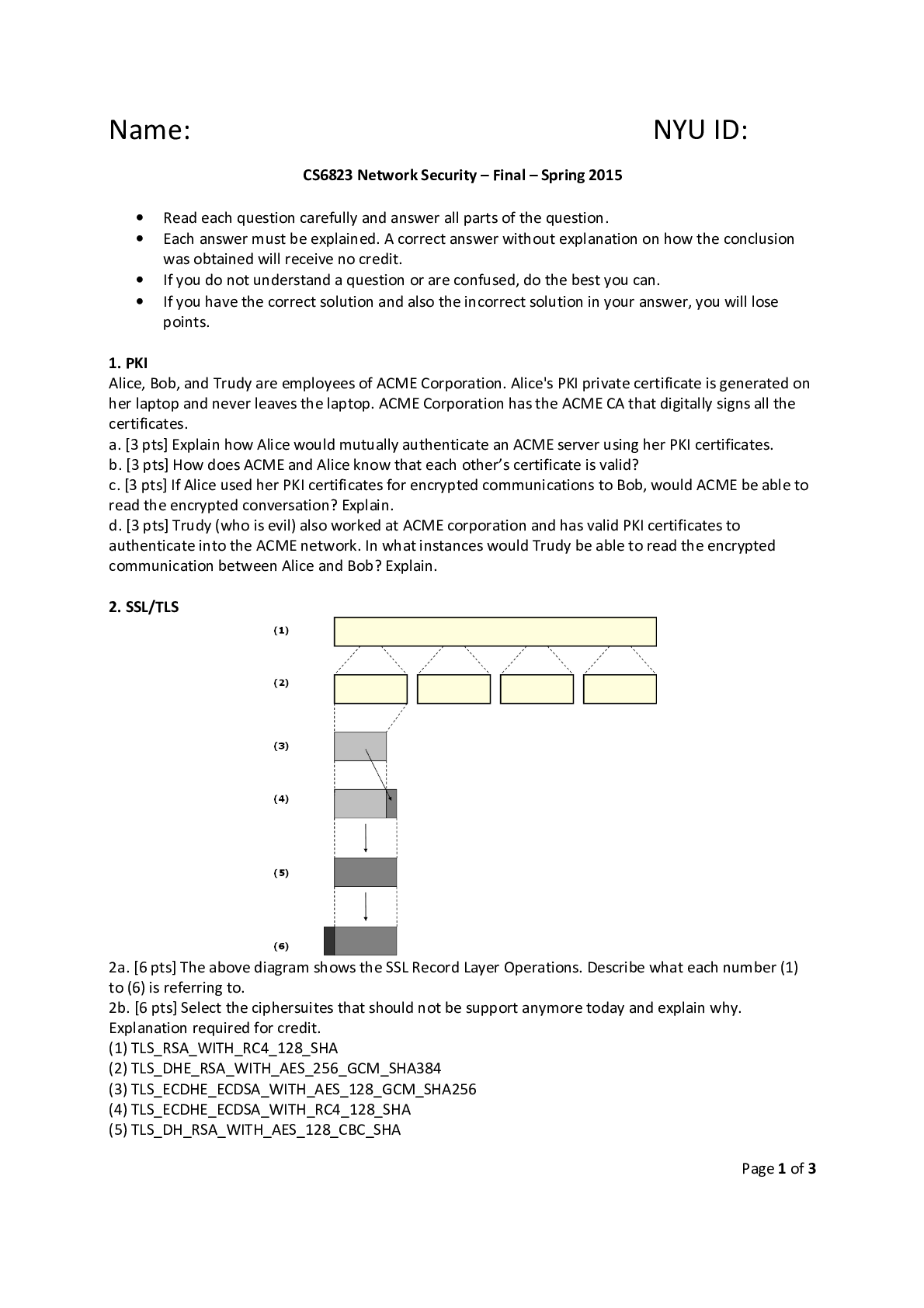


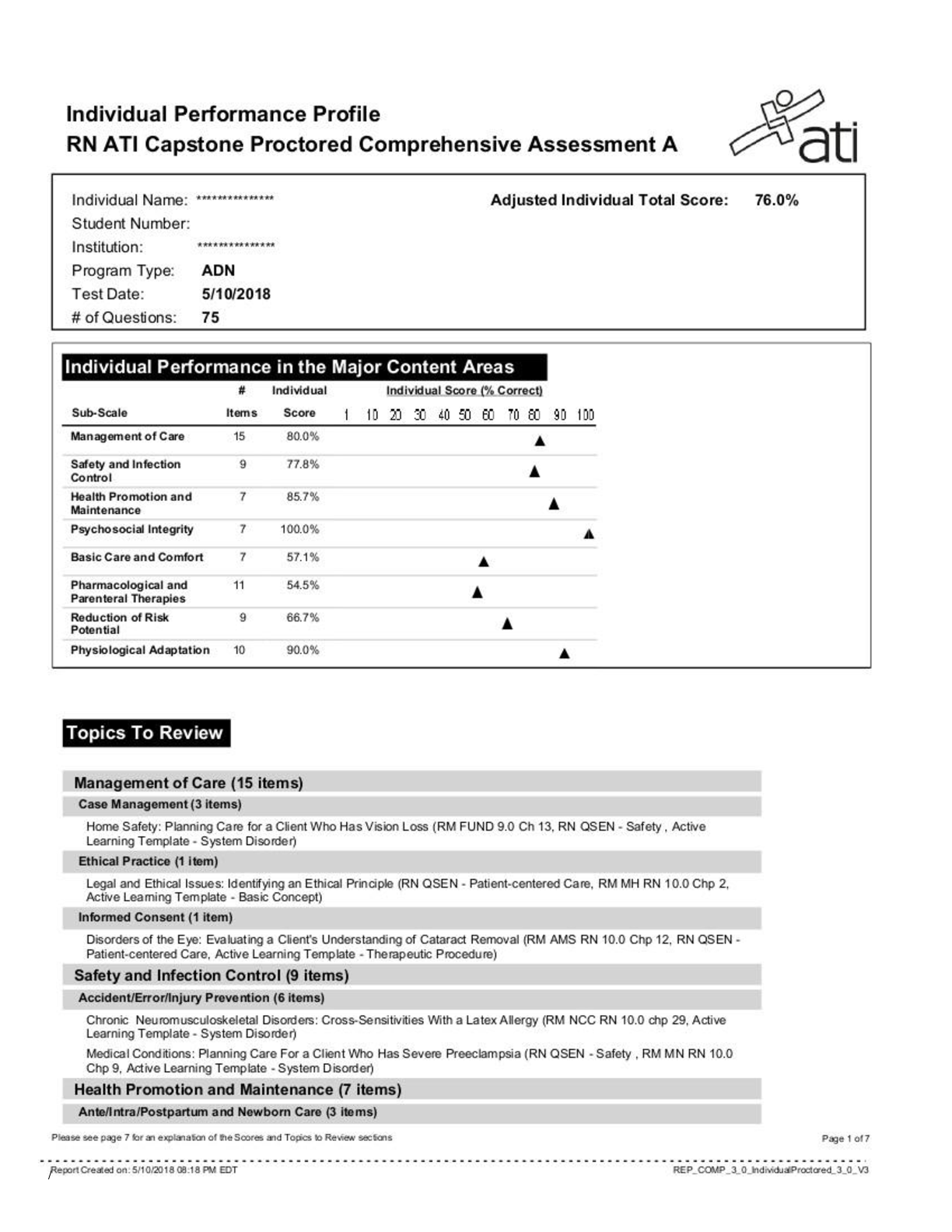
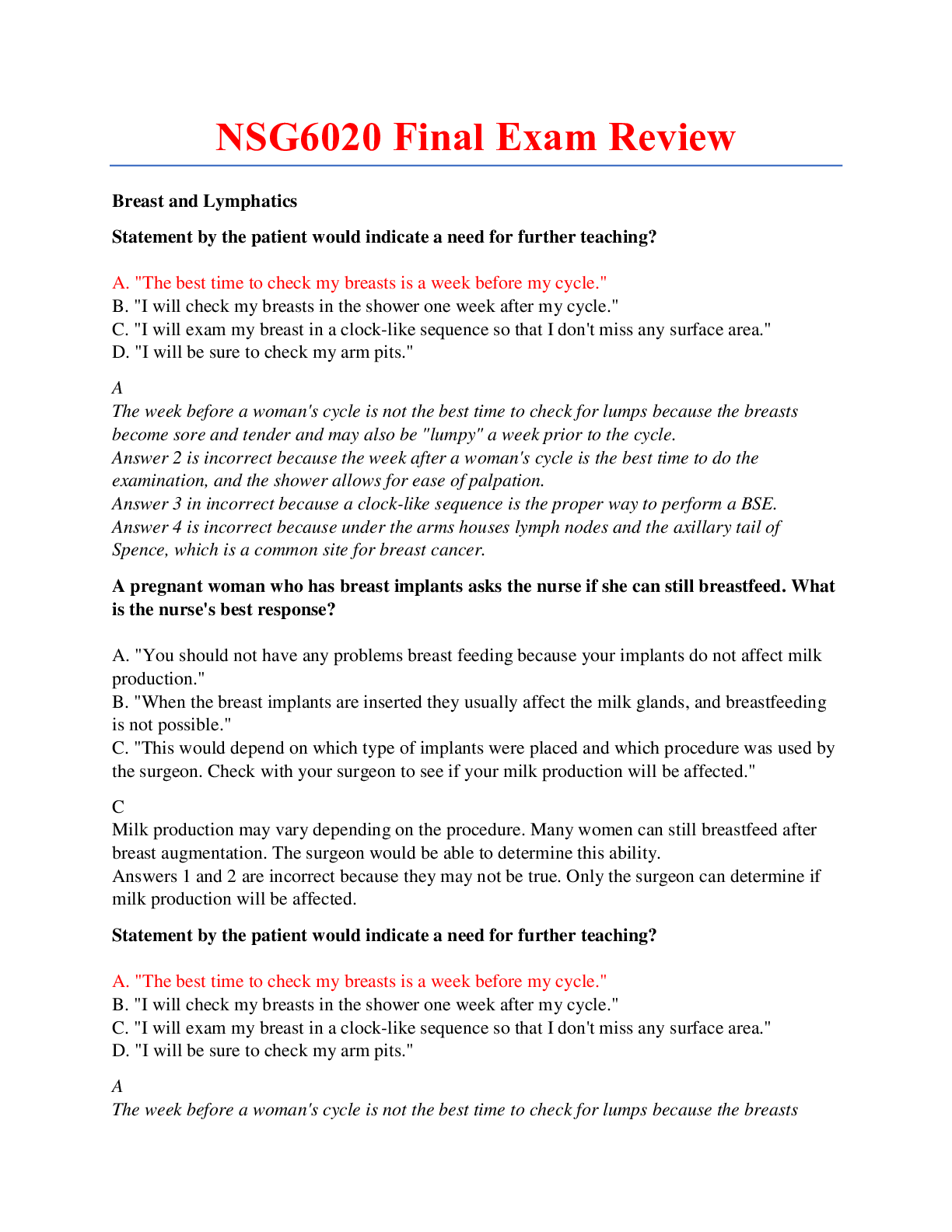

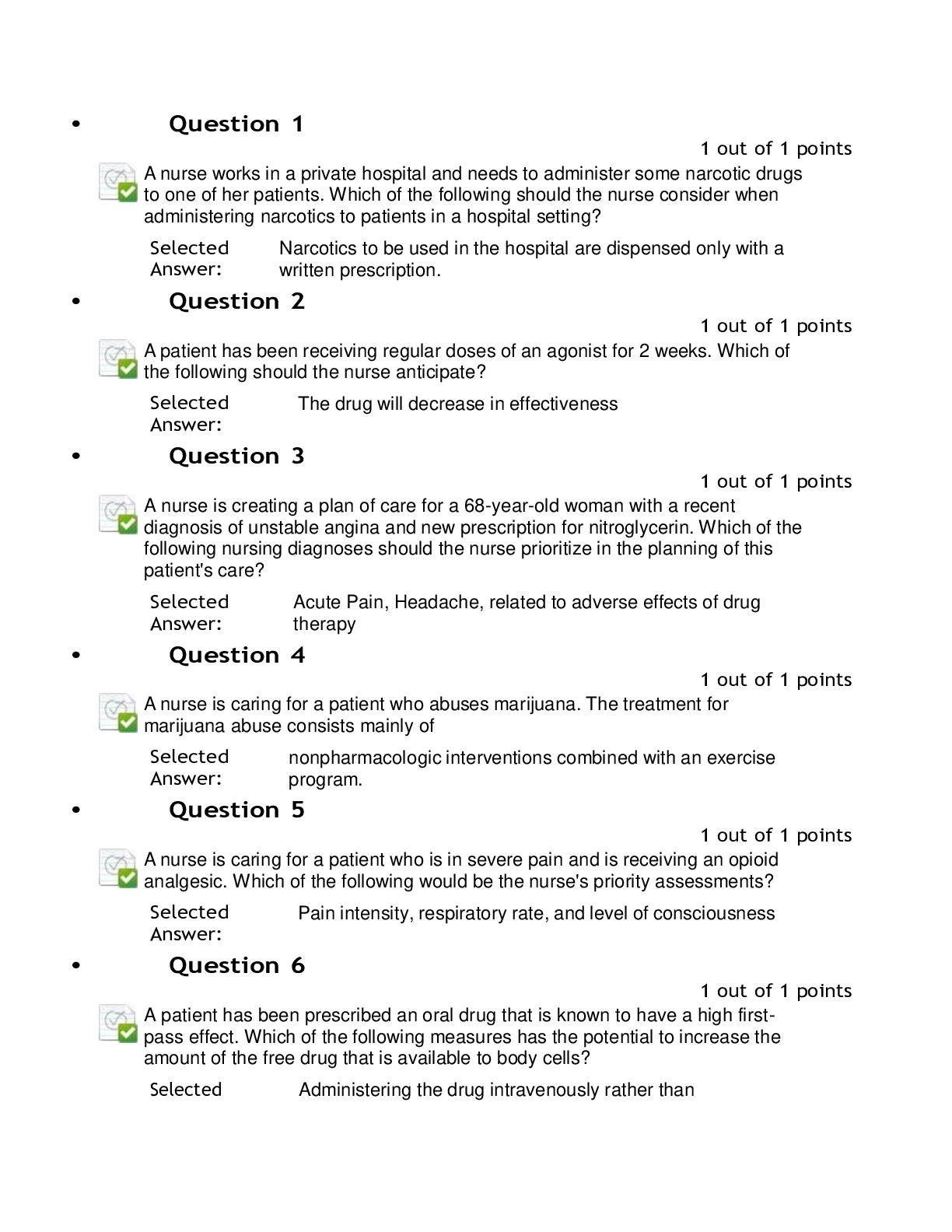

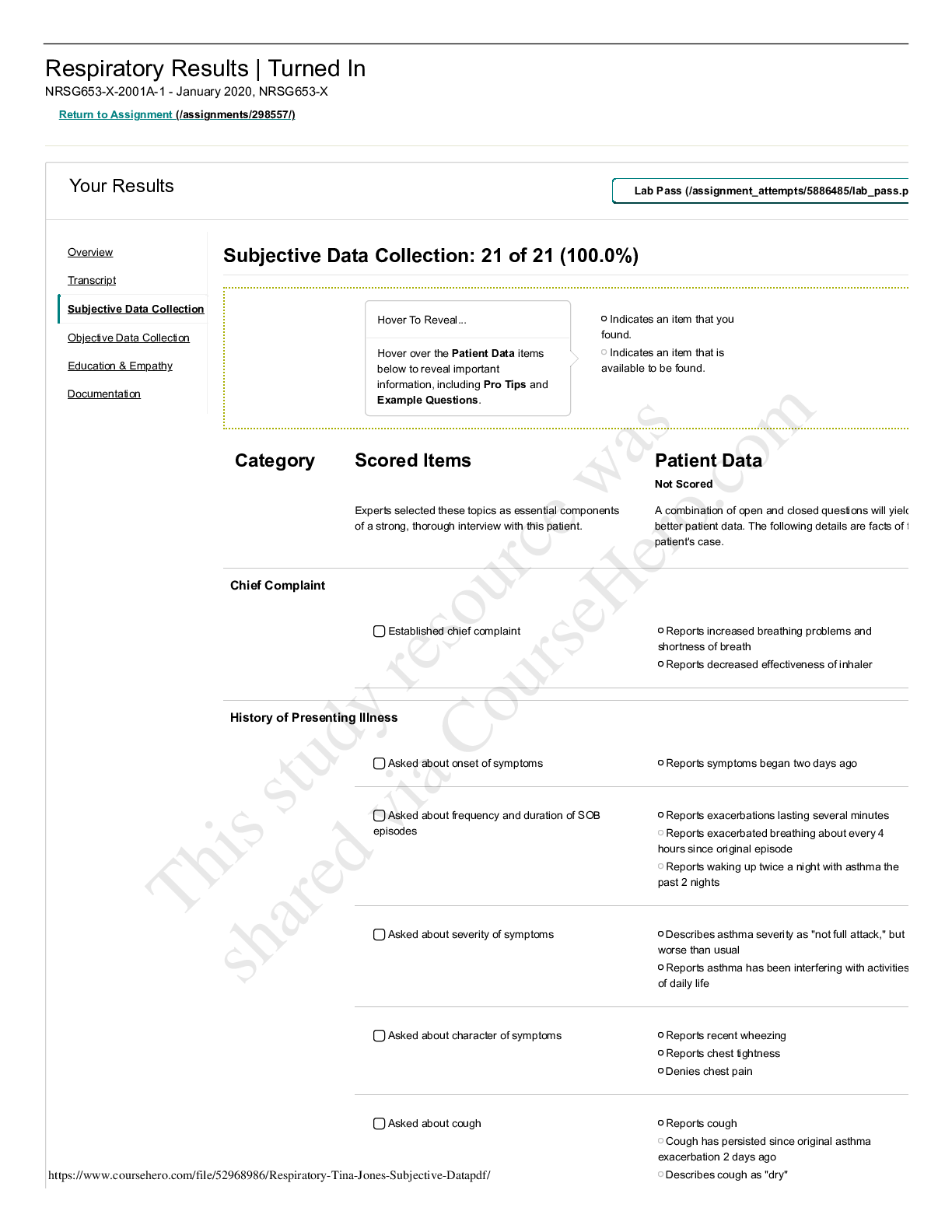




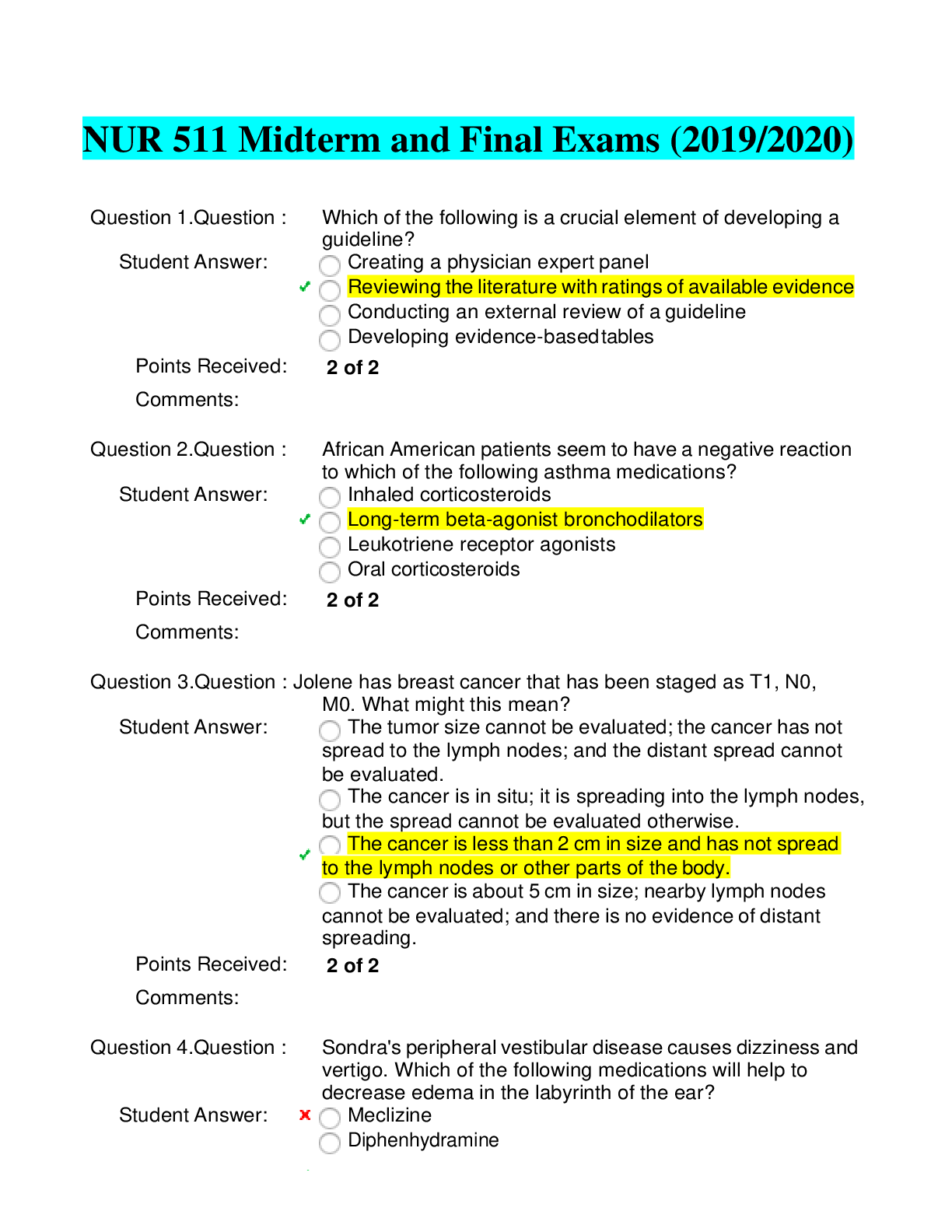
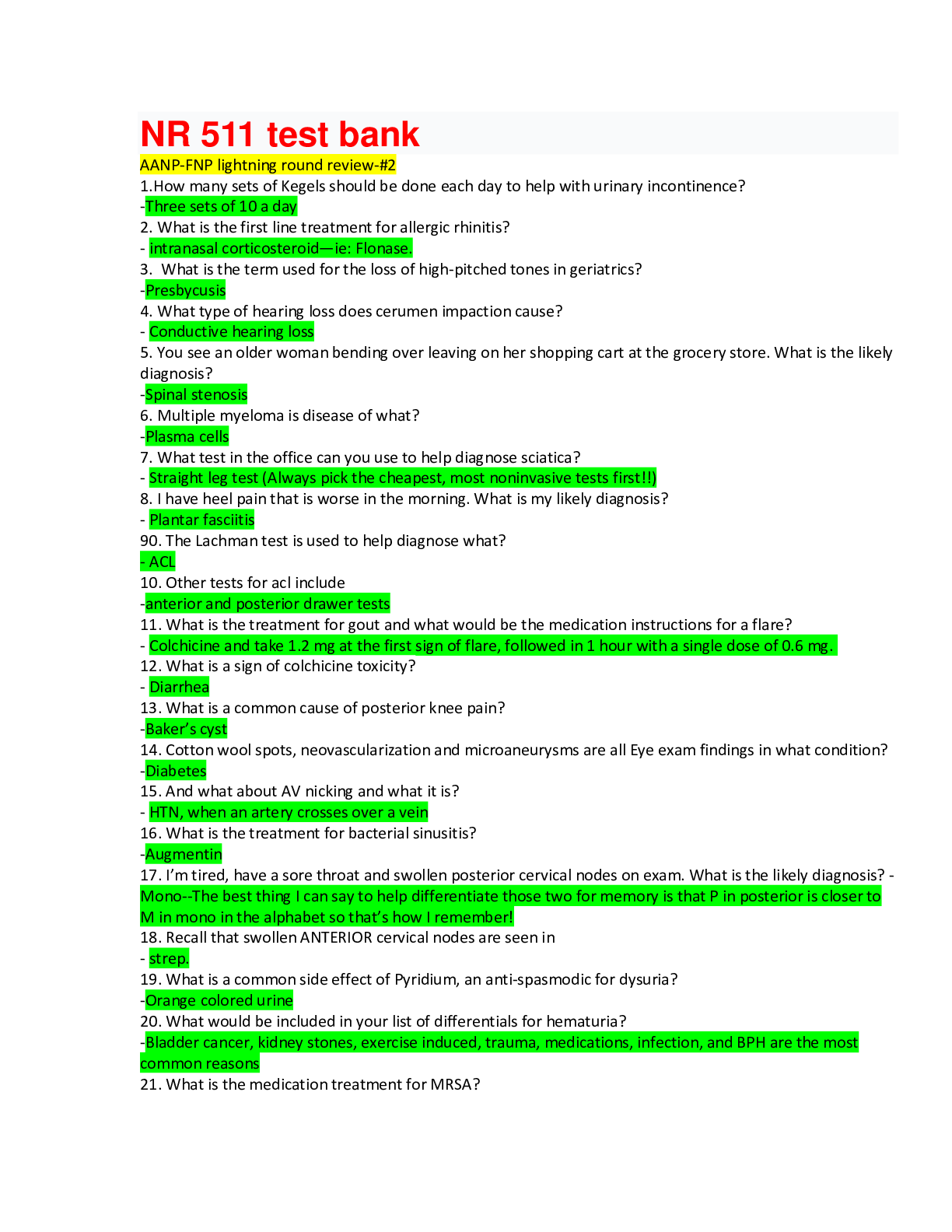
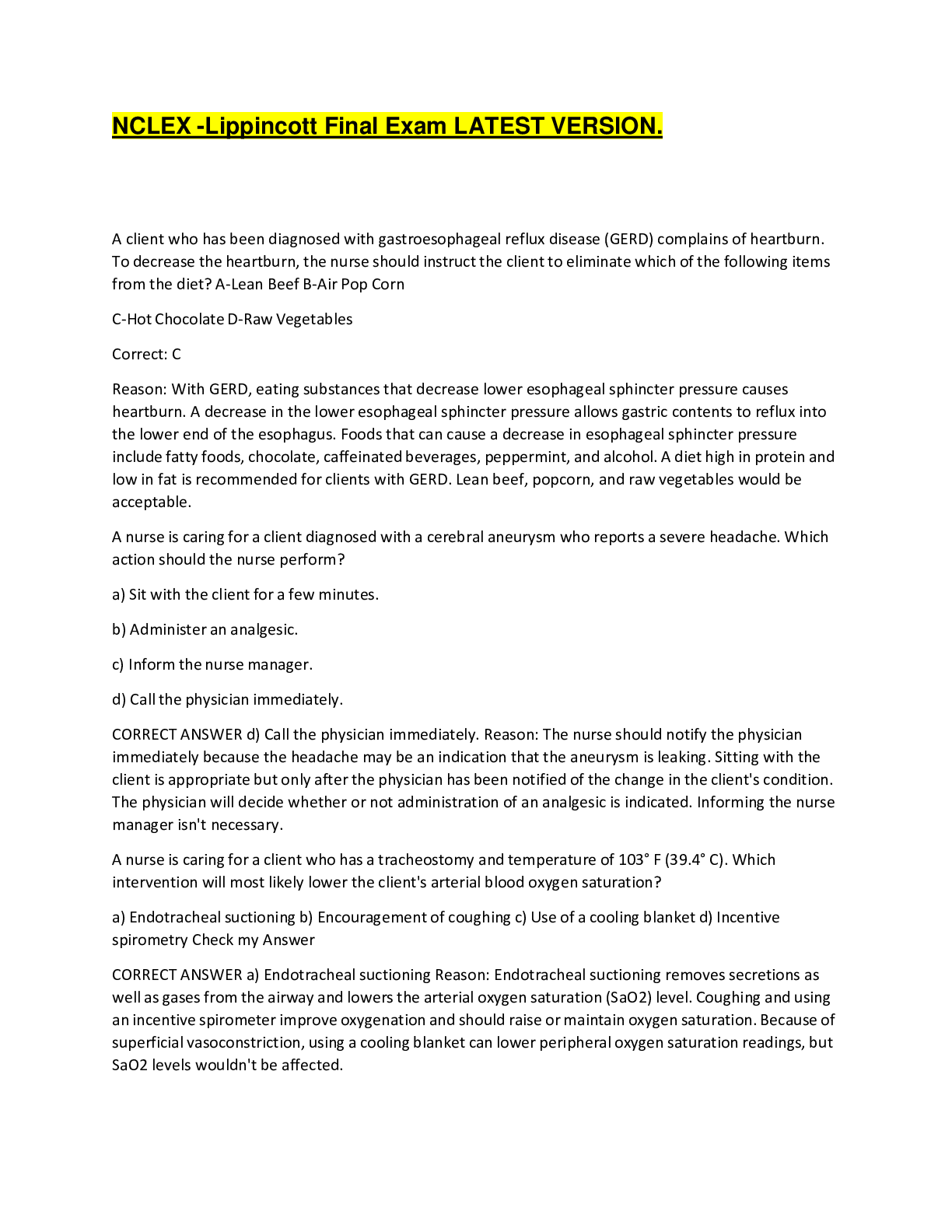

.png)
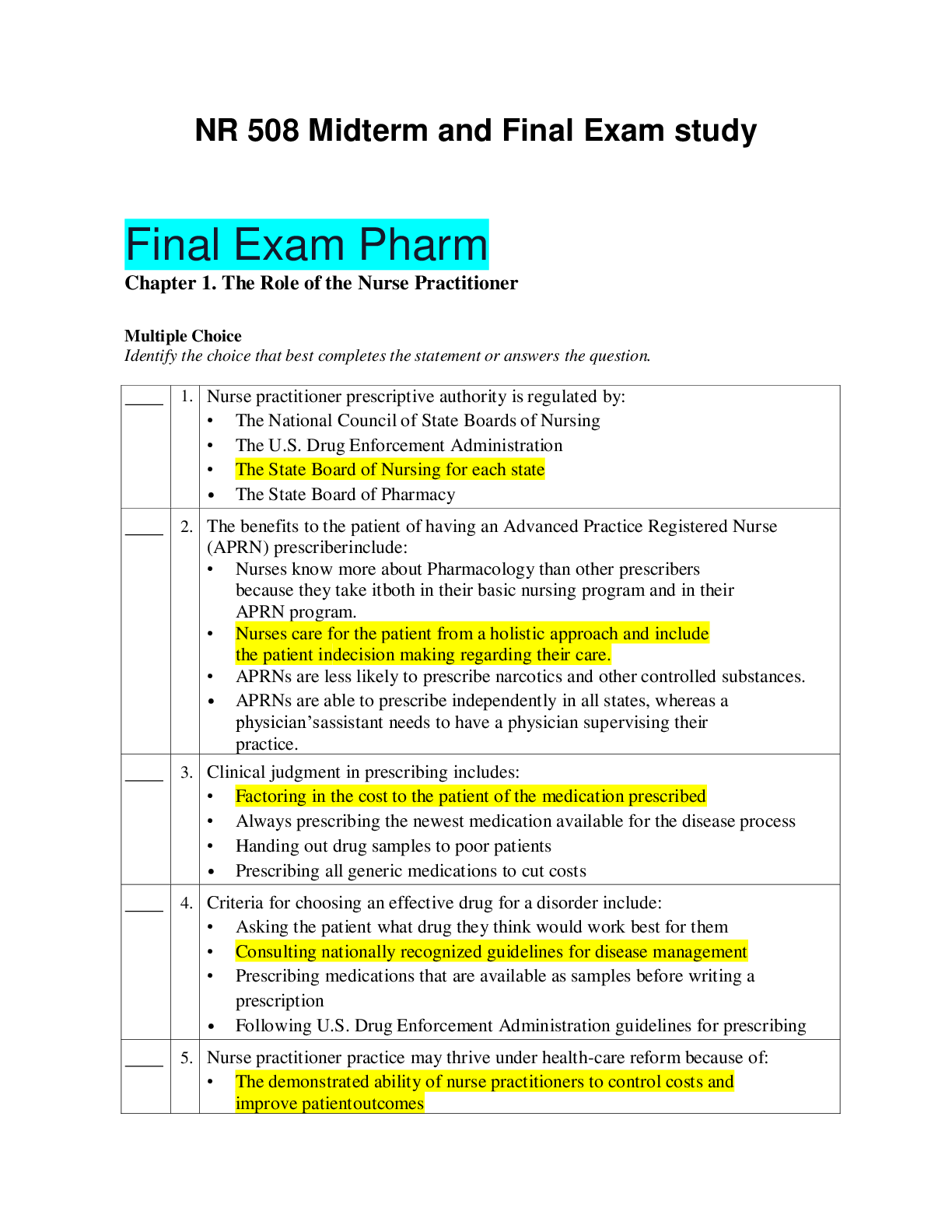
 (1).png)
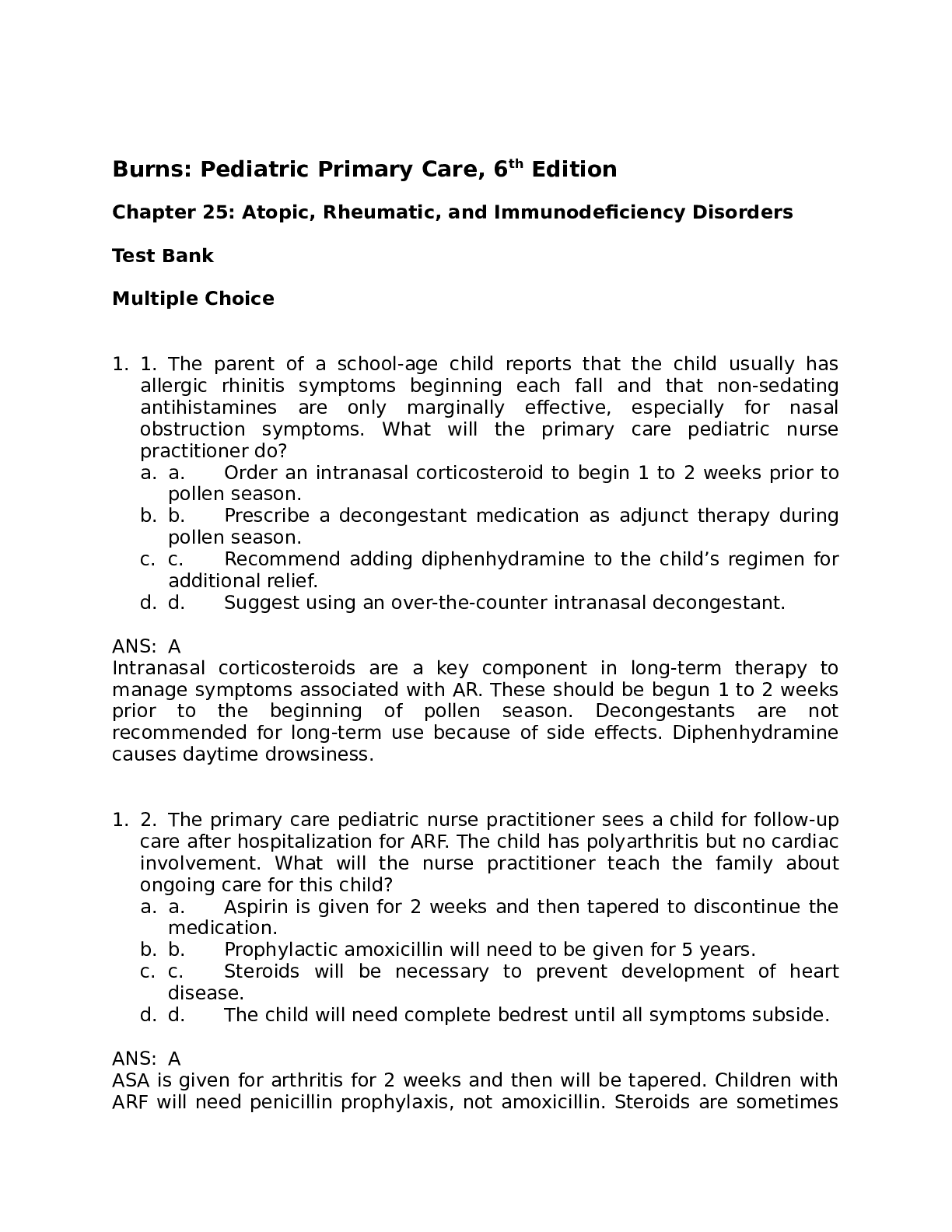

.png)

